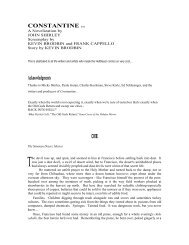Queer Keanu: Race, Sexuality and the Politics of - Whoa is (Not) Me
Queer Keanu: Race, Sexuality and the Politics of - Whoa is (Not) Me
Queer Keanu: Race, Sexuality and the Politics of - Whoa is (Not) Me
Create successful ePaper yourself
Turn your PDF publications into a flip-book with our unique Google optimized e-Paper software.
(Tom Hanks) in Philadelphia (1993). While <strong>the</strong> muchlauded Brokeback Mountain<br />
(2005) did feature sex scenes, <strong>the</strong> film could not be characterized as anything o<strong>the</strong>r than a<br />
tearjerker. Ultimately, both figures are victims <strong>of</strong> social norms, but <strong>the</strong>ir critique <strong>of</strong><br />
compulsory heterosexuality <strong>and</strong> racial separat<strong>is</strong>m <strong>is</strong> undercut by <strong>the</strong>ir final <strong>and</strong> inevitable<br />
expulsion, whe<strong>the</strong>r through ostrac<strong>is</strong>m or death, from society. While <strong>the</strong> tragic mulattas<br />
<strong>and</strong> <strong>the</strong> Boys in <strong>the</strong> B<strong>and</strong> br<strong>and</strong> <strong>of</strong> homosexuality may garner <strong>the</strong> sympathy <strong>of</strong> <strong>the</strong><br />
audience, <strong>the</strong> ultimate message <strong>is</strong> a warning. Beware <strong>of</strong> m<strong>is</strong>cegenation or homosexuality<br />
since it can only end badly.<br />
These familiar types converge with Reeves’ public <strong>and</strong> on-screen persona. As<br />
many <strong>of</strong> <strong>the</strong> articles <strong>and</strong> fan sites on Reeves note, a large part <strong>of</strong> h<strong>is</strong> appeal <strong>is</strong> h<strong>is</strong><br />
vulnerability <strong>and</strong> h<strong>is</strong> air <strong>of</strong> tragedy. Biographers unfailingly mention h<strong>is</strong> peripatetic<br />
childhood, h<strong>is</strong> estrangement from h<strong>is</strong> fa<strong>the</strong>r, h<strong>is</strong> fa<strong>the</strong>r’s arrest for drug possession, <strong>and</strong>,<br />
in more recent accounts, h<strong>is</strong> stillborn child, h<strong>is</strong> s<strong>is</strong>ter’s illness, <strong>and</strong> h<strong>is</strong> girlfriend’s<br />
automobile death. However, it <strong>is</strong> h<strong>is</strong> movies that fully exploit <strong>the</strong> passivity associated<br />
with h<strong>is</strong> vulnerability. Despite h<strong>is</strong> reputation as an action hero, Reeves <strong>is</strong>, by <strong>and</strong> large, a<br />
passive victim in many <strong>of</strong> h<strong>is</strong> films. DeAngel<strong>is</strong> argues that in h<strong>is</strong> first action film, Speed,<br />
Reeves’ character, Jack, reveals h<strong>is</strong> own weakness with “uncharacter<strong>is</strong>tically expressive<br />
intensity” (217). In addition <strong>the</strong> framing in <strong>the</strong> movie reinforces th<strong>is</strong> reading <strong>of</strong> Jack.<br />
DeAngel<strong>is</strong> says, “Jack’s vulnerability <strong>is</strong> conveyed not only by frequent high-angle <strong>and</strong><br />
overhead shots that emphasize h<strong>is</strong> helplessness, but also through plot elements that<br />
require <strong>the</strong> hero’s body to undergo elaborate gymnastic contortions” (215).<br />
In many <strong>of</strong> h<strong>is</strong> films Reeves <strong>is</strong> left defenseless because he know so much less than













